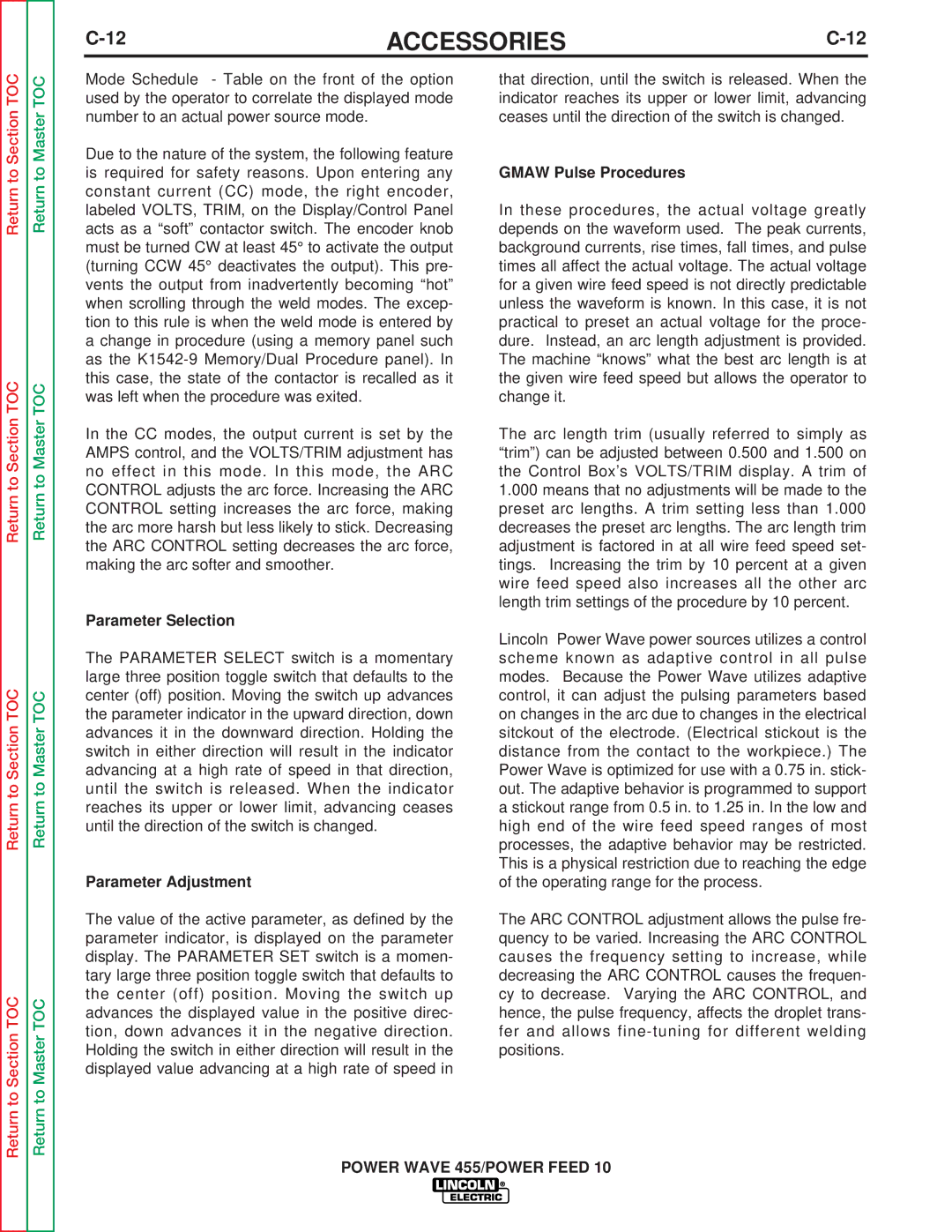
ACCESSORIES |
Return to Master TOC
Return to Master TOC
Return to Master TOC
Return to Master TOC
Mode Schedule - Table on the front of the option used by the operator to correlate the displayed mode number to an actual power source mode.
Due to the nature of the system, the following feature is required for safety reasons. Upon entering any constant current (CC) mode, the right encoder, labeled VOLTS, TRIM, on the Display/Control Panel acts as a “soft” contactor switch. The encoder knob must be turned CW at least 45° to activate the output (turning CCW 45° deactivates the output). This pre- vents the output from inadvertently becoming “hot” when scrolling through the weld modes. The excep- tion to this rule is when the weld mode is entered by a change in procedure (using a memory panel such as the
In the CC modes, the output current is set by the AMPS control, and the VOLTS/TRIM adjustment has no effect in this mode. In this mode, the ARC CONTROL adjusts the arc force. Increasing the ARC CONTROL setting increases the arc force, making the arc more harsh but less likely to stick. Decreasing the ARC CONTROL setting decreases the arc force, making the arc softer and smoother.
Parameter Selection
The PARAMETER SELECT switch is a momentary large three position toggle switch that defaults to the center (off) position. Moving the switch up advances the parameter indicator in the upward direction, down advances it in the downward direction. Holding the switch in either direction will result in the indicator advancing at a high rate of speed in that direction, until the switch is released. When the indicator reaches its upper or lower limit, advancing ceases until the direction of the switch is changed.
Parameter Adjustment
The value of the active parameter, as defined by the parameter indicator, is displayed on the parameter display. The PARAMETER SET switch is a momen- tary large three position toggle switch that defaults to the center (off) position. Moving the switch up advances the displayed value in the positive direc- tion, down advances it in the negative direction. Holding the switch in either direction will result in the displayed value advancing at a high rate of speed in
that direction, until the switch is released. When the indicator reaches its upper or lower limit, advancing ceases until the direction of the switch is changed.
GMAW Pulse Procedures
In these procedures, the actual voltage greatly depends on the waveform used. The peak currents, background currents, rise times, fall times, and pulse times all affect the actual voltage. The actual voltage for a given wire feed speed is not directly predictable unless the waveform is known. In this case, it is not practical to preset an actual voltage for the proce- dure. Instead, an arc length adjustment is provided.
The machine “knows” what the best arc length is at the given wire feed speed but allows the operator to change it.
The arc length trim (usually referred to simply as “trim”) can be adjusted between 0.500 and 1.500 on the Control Box’s VOLTS/TRIM display. A trim of 1.000 means that no adjustments will be made to the preset arc lengths. A trim setting less than 1.000 decreases the preset arc lengths. The arc length trim adjustment is factored in at all wire feed speed set- tings. Increasing the trim by 10 percent at a given wire feed speed also increases all the other arc length trim settings of the procedure by 10 percent.
Lincoln Power Wave power sources utilizes a control scheme known as adaptive control in all pulse modes. Because the Power Wave utilizes adaptive control, it can adjust the pulsing parameters based on changes in the arc due to changes in the electrical sitckout of the electrode. (Electrical stickout is the distance from the contact to the workpiece.) The Power Wave is optimized for use with a 0.75 in. stick- out. The adaptive behavior is programmed to support a stickout range from 0.5 in. to 1.25 in. In the low and high end of the wire feed speed ranges of most processes, the adaptive behavior may be restricted. This is a physical restriction due to reaching the edge of the operating range for the process.
The ARC CONTROL adjustment allows the pulse fre- quency to be varied. Increasing the ARC CONTROL causes the frequency setting to increase, while decreasing the ARC CONTROL causes the frequen- cy to decrease. Varying the ARC CONTROL, and hence, the pulse frequency, affects the droplet trans- fer and allows
POWER WAVE 455/POWER FEED 10
